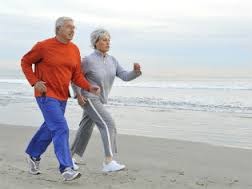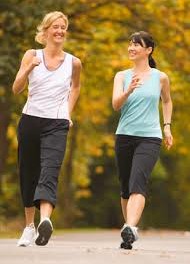Whether you like to admit it or not, the weather has an effect on your running and your performance. But there are tips and tricks to running both in the cold and the heat. It isn’t everyone who lives in a temperate climate.
The temperature affect on running in the cold will affect the warmth and flexibility of the muscles in the legs and arms making an injury more likely if the muscles are stretched quickly. When running in the cold the runner should pay attention to several factors.
Clothing: Run with a hat to retain heat in your body. No worries about hat head – just keep your body warm. Use layered clothing to provide the best warmth possible. Look for material that will wick moisture away from your body allowing it to evaporate. Your outer layer should be gortex to allow for evaporation of sweat and will allow you to stay warmer.

Decrease your outdoor running schedule: cold weather will negatively impact your immune system. Try to incorporate more treadmill running and halve your outdoor running schedule until the weather warms a bit.
Safety: Take a cell phone with you and let others know where you are. Snow and ice will increase your risk of fall and injury. Being caught out in the cold without a means of contacting friends or family can increase your risk of permanent injury to your limbs from frostbite.
Protect your skin: Your skin will take a beating from the cold. Use Vaseline over your face and thighs. The Vaseline will help to protect the skin from the cold and will keep the clothing from rubbing against your skin and causing sores.
Running in the wind: Running in the wind can be a real chore. Start your run out into the wind so as you are tired coming home you’ll have the wind to your back. Check the weather before you head out for the wind chill factor. If the temperature dips below zero or the wind chill below 20 below zero use the treadmill instead.
Don’t over dress: You will warm up as you get moving. Overdressing will cause you to overheat in the cold. Dress as if it’s 20 degrees warmer outside than it is. Heading into the wind you’ll be chilly at first but you’ll warm up quickly.
Don’t forget the sun: A problem people usually think of only in the summer but the winter sun can be just as damaging to the skin and eyes. Wear sunglasses and sunscreen when you head out in either the summer or winter.
Running in the heat has it’s own challenges. The temperature affect on running in the heat has some other issues that affect the runner. The weather must be accounted for with lighter clothing and material that also wicks moisture away from the body. When the temperature reaches 90-100F there is an increased risk of heat cramps and exhaustion; at 105 and above the possibilities of stroke and exhaustion are highly likely.
Running in the heat will result in overheating, even if there isn’t a risk of heat stroke. Overheating results from inadequate cooling when the body is unable to keep up with the evaporation from the skin. The body heats up internally and the skin can’t keep up with the cooling process because the blood is being used by the muscles to keep you running. Either the muscles use the blood to keep you moving or the skin uses the blood to cool your body. And, when the weather is very hot, this tug-of-war can result in overheating and heat exhaustion.
Part of the problem with running in the heat is dehydration. Dehydration is the loss of water from the body through sweat. When we sweat there is water and electrolytes lost which changes the way that our body functions. When working out in the heat for longer than 30 minutes consider a sports drink that replaces water and electrolytes.
Remember that thirst isn’t a good indicator of hydration. Once you are thirsty you are already low on fluid. People who are suffering from dehydration will experience an elevated heart rate during and after the run and urine that is dark yellow. Drink water consistently until the urine is clear. During your run drink between 4 and 8 ounces every 15 to 20 minutes of your run.
Runners can acclimate to the heat and humidity but it takes approximately 2 weeks for the body to run efficiently in warmer weather.
Run during the early morning hours to avoid as much of the heat as possible. There may be higher humidity but the air will be cleaner because the ozone levels increase as the day progresses and decreases in the early evening. As a runner the times to avoid are between noon and 3 pm.
Running in the heat may cause problems with heat cramps, heat exhaustion, and heat stroke. Athletes who suffer from heat cramps will experience muscle cramps or spasms, heavy sweating and a normal body temperature.
Athletes who are experiencing heat exhaustion will find themselves sweating profusely, a drop in blood pressure, normal or slightly elevated temperature, lightheadedness, nausea, vomiting, decreased coordination and possible fainting.
Athletes who experience heat stroke will exhibit high body temperatures, lack of sweating, red skin and altered consciousness. This is a medical emergency! People who are at greatest risk are those athletes who are exercising in hot humid conditions, are older, obese, wearing heavy clothing or running with an infection, fever or taking certain types of medications such as beta blockers, diuretics and amphetamines.
The temperature affect on running can be deterred when the runner and athlete takes full advantage of the technological advances in clothing and hydration as well as understanding the risks of injury in both cold and hot weather. It is most important that the athlete be aware of their surroundings and make accommodations that keep them healthy enough to run another day.
Resources:
Runners World: Training in the Heat
http://www.runnersworld.com/race-training/training-heat
San Diego State: Moderating Effects of the Climatic Environment
http://coachsci.sdsu.edu/csa/vol36/rushall1.htm
Over 40 Runner: Running in te Heat and Humidity
http://www.over40runner.com/info/RunningInTheHeat.html
Clinical Journal of sports Medicine: Effect of Environmental Temperature on Shock Absorption Properties of Running Shoes
http://www.ncbi.nlm.nih.gov/pubmed/15867561
Journal of Science and Medicine in Sports: Efect of Post-Exercise Hydrotherapy Water Temperature on Subsequent Exhaustive Running Performance in Normothermic Conditions
http://www.ncbi.nlm.nih.gov/pubmed/23246445
Jeff Galloway: Clothing Thermometer
http://www.jeffgalloway.com/training/tips_archives/seasonal.html
Runners World: 10 Tips for Running in the Cold
http://www.runnersworld.com/running-tips/10-tips-running-cold?page=single
Active: 4 Cold-Weather Running Tips for Beginners
http://beta.active.com/running/articles/4-coldweather-running-tips-for-beginners
Dr. Pributs: Running in the Cold
http://www.drpribut.com/sports/spcold.html
Fitday: Five Tips for Running in the Cold
http://www.fitday.com/fitness-articles/fitness/exercises/five-tips-for-running-in-the-cold.html





Leave a Reply